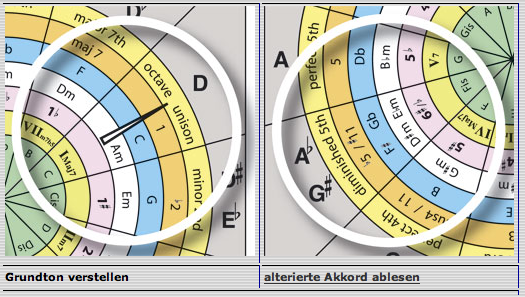Utilities Chord Clock
Chord-Clock
Latin Accordare = together sounding
With this tool all chords of a score can be decoded! It serves to translate the sometimes complicated chord symbols into notes. For that the chord symbols are first replaced by a numbering structure. On the utilities-wheel the numbers are arranged in a circle and show you the notes on the background that are contained in the sought chord
Altered chord
What is a chord?
A chord is the sound of three or more notes together. An exception are the so called power chords that contain only two notes (triad without third). The note sequence of a chord is variable (called inversion).
Whether C E G or E G C or G C E, it is always the same chord. Also allowed is the expansion of a chord with an octave with one of the chord notes (e. g. C E G E). It still is a triad!
Chord Structure
Normally chords consist of layers of thirds on top of each other. Rare are fourth chords that are built from diminished and augmented fourths or fifth chords that are built from layering fifths.
Scale Notes
For the construction of chords usually notes from the own scale are used. For the chords of the C major scale only the notes C, D, E, F, G, A and B are available. This is also the reason that either minor or major thirds come up. Chords that contain none scale notes are called altered chords.
Triads
The simplest chord is a triad. It is built by piling up thirds and contains 3 notes, the root, the third and the fifth (second third). Minor and major thirds produce 4 combinations of piling up thirds with the C Major scale.
The fourth combination is not part of the C major scale triads.
Triads of the C Major Scale
Recipe for the construction of a seventh chord
Root + next but one note + next but one note
Example C Triad
Seventh Chords
A seventh chord is triad that is extended by an additional third. The chord consist of the root, a third, a fifth and a seventh and is called therefore a seventh chord.
Recipe for the construction of a seventh chord
Root + next but one note + next but one note + next but one note
Example C Seventh Chord
Maj7, j means that the major seventh is contained in the chord. 7 means that the minor seventh is contained in the chord. b5, 5- means that the diminished fifth is contained in the chord. The most used chord is the dominant seventh chord. It consist of a major triad and a minor seventh (e. g. G7)
Expanded Chords 7 9 11 13
A diatonic expanded chord has five, six, or seven notes. The seventh chord and therefore the characteristic of the chords (major, minor, dominant7) is unchanged. An expansion adds also an accent or a different sound color. By piling up additional thirds five note chords (ninth chords), six note chords (eleventh chords) or seven note chords (thirteenth chords) can be formed.
Those expanded chords a rarely used in their entire form. Most common is to play the base triad (with or without fifth) with the additional ninth (minor/major), eleventh (minor/major) or thirteenth (minor/major).
Suspended Chords
You have might seen the chord Csus4. It is called a suspended chord (suspended fourth) and contains a fourth instead of the third. The chord Csus9 has a D instead of a C.
Altered Chords
Altered chords are used in Jazz to produce more tension. This tension is produced by none scale notes. The fifth (5) and the ninth (9) are decreased or increased by half a tone. The fourth (4 or 11) are increased by half a tone and the thirteenth (13) is decreased by half a note. Alterations are indicated by the symbols (+ or -) or with the sign (# or b).
Here are some examples:
Of course for the altered chords the Diminished Whole Note scale fits. It is located on the Dom7 color circle.
Diminished Chords
Two minor thirds piled up result in a diminished triad.
Three minor thirds piled up result in a diminished seventh chord. It is also a diminished triad with a minor seventh. With the first minor third the chord already has a minor character.











